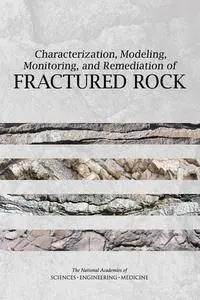Characterization, Modeling, Monitoring, and Remediation of Fractured Rock
National Academies of Sciences, Engineering, and Medicine; Division on Earth and Life Studies; Board on Earth Sciences and Resources; Committee on Geological and Geotechnical Engineering
NAS Press | 2015 | ISBN: 0309378982 0309373727 9780309373722 9780309378987 | 194 pages | PDF | 12 MB
National Academies of Sciences, Engineering, and Medicine; Division on Earth and Life Studies; Board on Earth Sciences and Resources; Committee on Geological and Geotechnical Engineering
NAS Press | 2015 | ISBN: 0309378982 0309373727 9780309373722 9780309378987 | 194 pages | PDF | 12 MB
This book examines the state of practice and state of art in the characterization of fractured rock and the chemical and biological processes related to subsurface contaminant fate and transport. The recommendations for research and applications to enhance practice of this book make it a valuable resource for students and practitioners in this field.
Fractured rock is the host or foundation for innumerable engineered structures related to energy, water, waste, and transportation. Characterizing, modeling, and monitoring fractured rock sites is critical to the functioning of those infrastructure, as well as to optimizing resource recovery and contaminant management.
With an interdisciplinary approach, it is possible to conceptualize and model the fractured rock environment with acceptable levels of uncertainty and reliability, and to design systems that maximize remediation and long-term performance. Better scientific understanding could inform regulations, policies, and implementation guidelines related to infrastructure development and operations.
This volume examines new developments, knowledge, and approaches to engineering at fractured rock sites since the publication of the 1996 National Research Council report Rock Fractures and Fluid Flow: Contemporary Understanding and Fluid Flow. Fundamental understanding of the physical nature of fractured rock has changed little since 1996, but many new characterization tools have been developed, and there is now greater appreciation for the importance of chemical and biological processes that can occur in the fractured rock environment.
The findings of Characterization, Modeling, Monitoring, and Remediation of Fractured Rock can be applied to all types of engineered infrastructure, but especially to engineered repositories for buried or stored waste and to fractured rock sites that have been contaminated as a result of past disposal or other practices.
The recommendations are intended to help the practitioner, researcher, and decision maker take a more interdisciplinary approach to engineering in the fractured rock environment.
The book describes how existing tools
– some only recently developed
– can be used to increase the accuracy and reliability of engineering design and management given the interacting forces of nature.
Contents
Summary
1 Introduction
The Context
The Committee Task
Previous Academies Studies
The Heterogeneity of Fractured Rock
Contaminants in Fractured Rock
Fate and Transport
Knowledge from Related Areas
Report Organization
2 Physical Characteristics of Fractured Rock Controlling Flow and Transport
Qualitative Fracture Description
Quantitative Fracture Description
Importance of Fracture Genesis
3 Flow and Transport–Underlying Processes
Advection and Dispersion
Hydro-Mechanical Coupling
Chemical Processes: Diffusion and Reaction
Biological Processes
Mixed-Fluid Conditions
Fines Migration and Entrapment: Emergent Transport Processes
Heat Transport and Thermal Processes
4 Conceptual and Numerical Model Development
Defining and Developing Hydrostructural Models
Quantifying the Hydrostructural Model
Scoping Calculations to Assess and Refine Models and Uncertainties
Analysis Tools to Inform Modeling
Types of Numerical Models
Upscaling and Model Simplification
Numerical Model Analysis
Analysis and Resources
5 Methods for Site Characterization and Monitoring
Geomechanical Characterization
Geometric Characterization
Hydraulic Characterization of Fractured Rock
Geophysical Characterization of Fractured Rock
Geochemical Characterization of Fractured Rock Systems
Biological Characterization of Fractured Rock
6 Remediation of Fractured Rock
Difficulties of Remediation in Fractured Rock
Potential Technologies to Remediate Organic Compounds
Potentially Applicable Approaches for Radionuclides
Natural Attenuation
Important Considerations in Fractured Rock Remediation
The Path Forward
7 Decision Making
Decision Making and Updating in the Context of this Report
Observational Method in Geotechnical Engineering
Evolving the Observational Method to Geoenvironmental Engineering
8 Synthesis of Recommendations
An Integrated Approach
Interactions Between Rock Matrix and Fractures
Processes and Coupled Processes
Characterization Techniques and Tools
Modeling
Remediation and Monitoring
The Observational Approach
Final Thoughts
References
APPENDICES
true PDF with TOC BookMarkLinks



